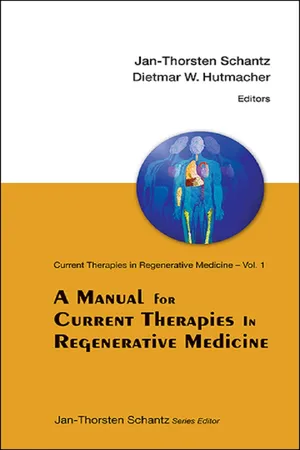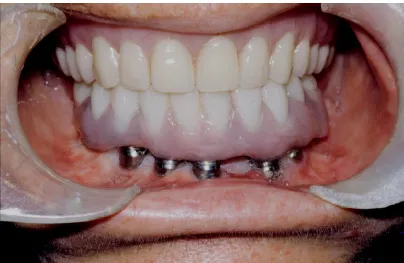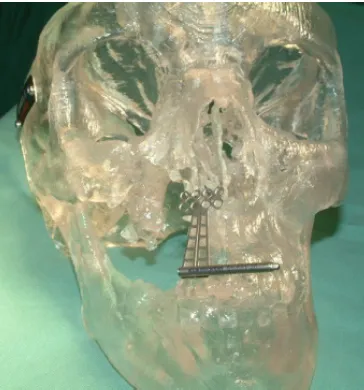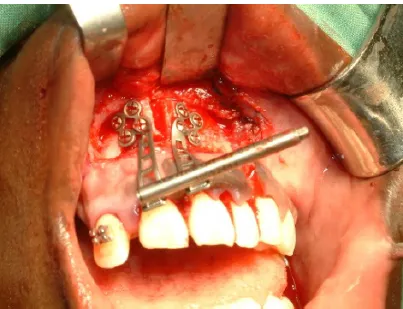
A Manual for Current Therapies in Regenerative Medicine
- 480 pages
- English
- ePUB (mobile friendly)
- Available on iOS & Android
A Manual for Current Therapies in Regenerative Medicine
About This Book
The emerging field of regenerative medicine has led to a paradigm shift in therapeutic procedures. Scientific discovery in stem cell biology and material sciences, as well as in genetics have resulted in clinical concepts that focus on regeneration rather than repair. Also, translational research provided mankind with therapeutic tools to grow complex tissues and organs for transplantation into patients. These new technologies not only benefited patients but they also have significant socioeconomic potential.
This manual aims to provide an overview on a variety of clinically applied strategies in the current field of regenerative medicine, and it also contains concise key data for a rapidly growing industry. As such, both patients and doctors will find the information contained within this manual to be useful and relevant. The editors are both international leaders in the field of regenerative medicine, and both possess a broad spectrum of experience from basic research to clinical application and commercialization.
Contents:
- Regenerative Medicine: From Historic Developments to State-of-the-Art Therapies:
- Aspects of Tissue Engineering and Regenerative Medicine in Maxillofacial Reconstruction (Geoff McKellar and Ann Collins)
- Regenerative Medicine Using Biomaterials:
- Regenerative Medicine in the Craniofacial Field (Erin Miller, Harvey Chim and Jan-Thorsten Schantz)
- Calvarial Reconstruction by Computer-Aided Design of Bioactive Scaffolds (F A Probst, T C Lim, D W Hutmacher and J T Schantz)
- Treatment of Long Bone Defects and Non-Unions: From Research to Clinical Practice (A Berner and D W Hutmacher)
- Cell-Based Cartilage Repair Utilising Collagen Type I Hydrogel Scaffolds (CaReS ® ) (Lars Rackwitz, Stephan Reppenhagen, Johannes C Reichert, Thomas Barthel, Maximilian Rudert and Ulrich Nöth)
- Ear and Nose Cartilage Tissue Engineering (Daniel Skodacek, Katharina Storck and Rainer Staudenmaier)
- Regenerative Medicine Using Cells:
- Stem Cell-Based Therapies (Sebastian Sauerbier, Julia Obermeyer, Ralf Gutwald and Rainer Schmelzeisen)
- Adipose Tissue Engineering — The Evolution of Clinical Applications in Breast Surgery (Paul Wiggenhauser and Peter Rubin)
- Autologous Bone Marrow Cell Therapy in Peripheral Artery Disease (Berthold Amann and Claas Lüdemann)
- Structural Fat Grafting for Rejuvenation of the Hand: How Much Volume do We Get? (Giunta RE, Eder M, Müller D, Kovacs L and Machens HG)
- Development of Bioartificial Myocardium Using Stem Cells and Nanobiotechnology Templates (Juan Carlos Chachques)
- Airway Biological Engineering (Silvia Baiguera and Paolo Macchiarini)
- The “Twice Born Dionysus” — A Lesson from Mythology (Germano Di Sciascio and Maria Cecilia Scimia)
- Regenerative Medicine Using Bioactive Factors:
- Erythropoietin and Its Role in Regenerative Medicine (Christina Irene Günter and Hans-Günther Machens)
- A Practical Introduction to Prolotherapy and Regenerative Injection Therapy Using Platelet-Rich Plasma (Harry Adelson)
- The Future of Regenerative Medicine: The Undoing of Ageing (Aubrey de Grey)
Readership: Scientists and engineers in the field of regenerative medicine; clinicians and specialists; and patients or the general public who wish to know about specific treatment options.
Frequently asked questions
Information
Regenerative Medicine:
From Historic Developments
to State-of-the-Art Therapies
1
Aspects of Tissue Engineering and Regenerative Medicine in Maxillofacial Reconstruction
Geoff McKellar*, Ann Collins†
Oral and Maxillofacial Surgeons
*Westmead Hospital and the Children’s
Hospital, Sydney, Australia
†University of Sydney, Australia
1.1 Introduction
- Morphogenetic signals.
- Responding stem cells.
- Extracellular matrix scaffolding.
1.2 Historical Developments Adapted to Aid Maxillofacial Reconstruction


1.2.1 Gavril Ilizarov: Distraction osteogenesis 52,53


1.2.2 Marshall Urist: Bone morphogenic protein and platelet-rich plasma 3–5,13,14,83,84
Table of contents
- Cover
- SubTitle
- Current Therapies in Regenerative Medicine
- Title
- Copyrights
- Dedication
- Authors
- Foreword
- Preface
- Contents
- ContributingAuthors
- Section 1
- Section 2
- Section 3
- Section 4
- Index